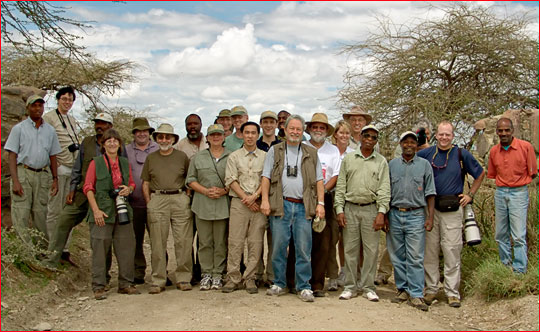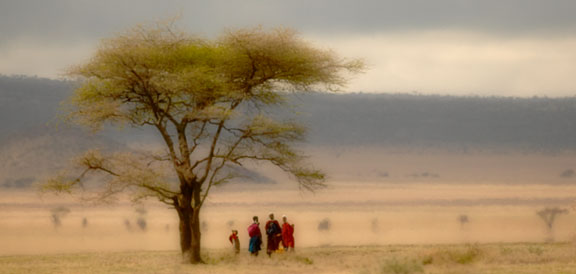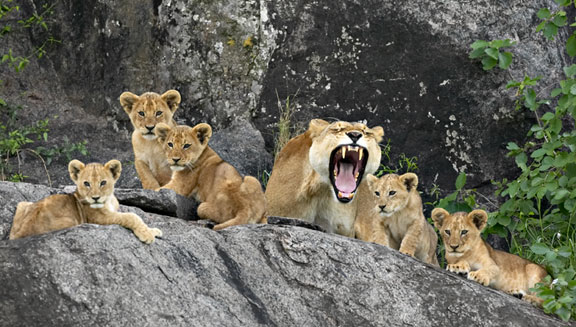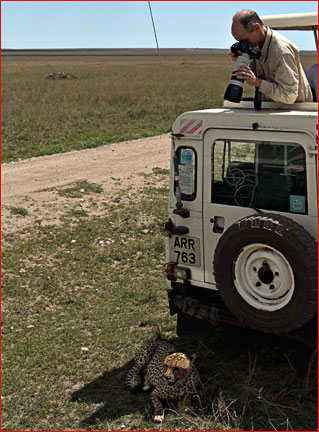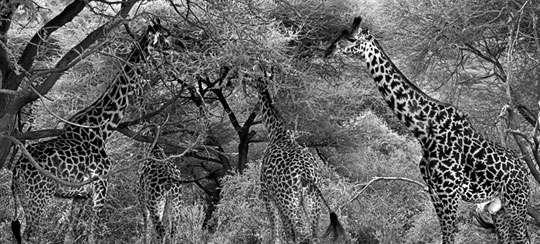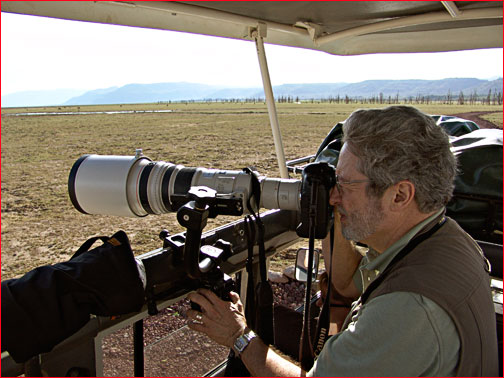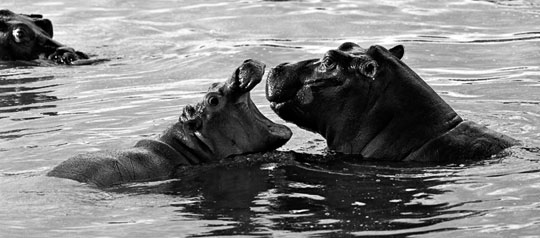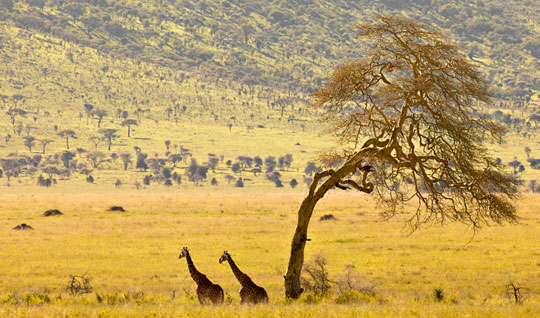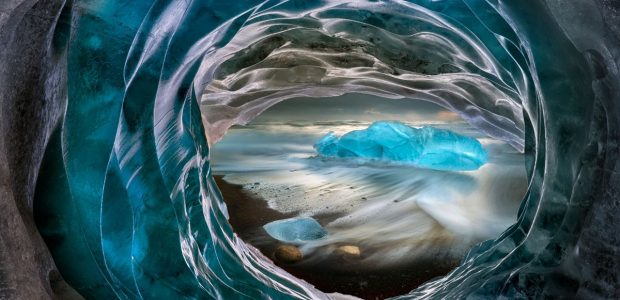At the Gates of Serengeti National Park
Workshop Safari members and guidesLocations
First, a word about Africa, and Tanzania in particular. There are a great many places for wildlife viewing in sub-Saharan Africa. But regrettably many of the countries in Africa are unsafe for Western tourists, for various reasons.
Tanzania has a relatively stable government and is about as safe as anywhere on the continent, especially if you spend as little time as possible in the cities. You have a greater chance of being eaten by a lion than of being mugged or robbed, and the chances of an unpleasant meeting with asimba(Swahili for lion) are small indeed. Be aware though that Tanzania is one of the poorest countries in the world, with a per capita income of about U.S. $250. It is important not to flaunt ones possessions or large amounts of cash when in urban areas.
Tanzania is home to theSerengeti, a vast plane (savanna) containing one of the world’s largest and most varied wildlife habitats. It is connected in the north of the country toKenyaand theMasai Mara, which is an extension of the Serengeti. Several things combine to make this a unique place to visit and a superb place to do photography — of wildlife as well as landscapes and people.
Masai Waiting — Ngorongoro, Tanzania. January, 2004Canon 1Ds with 500mm f/4L IS lens @ ISO 400
Firstly there is the concentration of wildlife. It is quite possible to see elephants, rhinos, wildebeest (gnu), lions, leopards, giraffes, cape buffalo and cheetahs, all within the space of an hour, or less! Secondly, there is the stunning landscape — magnificent acacia trees, open planes, forested areas and the huge African skies. This also is the purported home of humanity; theOlduvai Gorgewhere theLeakiesfound human predecessors, which is located within the Serengeti, and is a must-visit while there.
Without sounding too romantic about it, there is something about the look, the smell and the sounds of the Serengeti that almost seems to be part of ones racial memory. Hard to describe, but shared by almost everyone that visits there. There is a “rightness” about it that infuses ones spirit. Being immersed in it, along with the astonishing assortment of animals, all in their natural environment — which they have called home for millennia — is an experience that I wish more people could share.
Tanzania is ecology conscious and goes to considerable lengths to protect its natural environment, sometimes in conflict with its people. While Tanzania is home to many different tribal groups, the Serengeti is home to theMasai, a tribe which has resisted assimilation into the modern world. You see them in the towns as well as on the savanna where they heard their cattle wearing their traditional red robes, though in the towns they can be seen in their traditional garb but also wearingNikes.
________________________________________________
Photo Equipment Selection
Protecting the Cubs. Serengeti — Tanzania. January, 2004Canon 1Ds with 500mm f/4L IS lens @ ISO 400
For photographers the big question when going onsafari(a Swahili word for journey) is what to bring in the way of equipment. Here’s what I brought, based on extensive previous experience doing wildlife photography, and also based on consultations withAndy Biggs, who is an experienced photographic workshop guide to Tanzania.
I brought three camera bodies and three interchangeable lenses on this trip; theCanon 1Ds,Canon 10DandSony F828. The lenses for the Canon were theCanon 16-35mm f/2.8L,70-200mm f/2.8L ISand500mm f/4L IS. The Sony had, of course, its permanently fitted28-200mm f/2-2.8 Zeiss Sonnar. I also had along Canon 1.4X and 2X Extenders.
Polarizing filters for all the lenses, a flash and Better Beamercompleted the main equipment selection. Of course I had all the requisite batteries, changers, car AC inverters, sensor cleaning tools and the myriad of little accessories that one carries on such a trip.
I used the Canon 1Ds together with the 500mm f/4 about 95% of the time. Occasionally I would put on the 70-200mm, but usually the 10D was attached to that lens. I tried to change lenses as infrequently as possible to minimize the need for sensor cleaning in the extremely dusty conditions. Even so, this task was a must each evening because on the 1Ds I was constantly adding and removing the 1.4X Extender which, no matter how careful I was about trying to minimize the intrusion of dust into the camera body, lead to the inevitable sensor dust spots.
The little Sony F828 was the second most used camera, after the 1Ds and 500mm combination. It sat either in the pouch of the seat-back in front of me, or hung around my neck when we were able to be outside the vehicles. It was used primarily for photographs of people and landscapes, though it was also used for wildlife when they came close to the vehicle.
Acacia and Cloud. Serengeti — Tanzania. January, 2004Sony F828 @ ISO 64
As for traveling with all this gear, I was able to get all of the cameras and lenses (except the 500mm) into aLowepro Minitreckerbackpack. For traveling the 500mm simply was carried over my shoulder without a case or bag. I have a backpack style case for it, but that would have meant two airline carry-on bags, which is not allowed. The lens by itself though is ignored by the airlines (though not by airport security, who regard anything of that size as worthy of closer inspection). I have had no problem with this method of carrying a large super-telephoto when traveling anywhere in the Americas, Europe or Africa.
Parenthetically — one of the trip members who also had along a Canon 500mm f4/L IS (bought just weeks before the trip) had the misfortune of having it tumble off the roof of his Land Rover onto the road, a fall of about 8 feet. The 1.4X Extender that was attached to it shattered, but the 500mm survived with nothing worse than some cosmetic scratches to the body. All of the glass was fine. These are incredibly tough lenses, and so a bit of bumping around in the overhead bin of an aircraft will produce no ill effects.
Be aware that Tanzania, unlike neighboring Kenya and several other African countries, does not allow off-road driving in its national parks and nature reserves. This means that as a photographer, at times you may not get as close to animals as you would like. For example, if there’s a cheetah kill 100 feet from the road, your driver will not drive across the savannah for a closer look. He’d lose his license. Consequently, and all other things being equal, you will typically need a longer lens for shooting in Tanzania than you will in some other countries. Also, the open savannah means that the animals have a much wider range of movement than in some other countries where you can get closer to the animals at times, but your view is obstructed by trees and bushes.
Perry Smith photographs Cheetah dandruffDon’t misunderstand this though; in our 8 days of shooting we often found ourselves within spitting distance of lion and cheetah kills, leopards, elephants and another exotic animals. The plane is crisscrossed with vehicle tracks, and wherever there are tracks, you can drive. Finally, I must say that from an environmental perspective the Tanzanian approach to animal protection is to be preferred. Twenty Land Rovers converging on a lion kill at the same time isn’t exactly the most animal friendly environment.
________________________________________________
Thomson Safaris
One can not travel in the National Parks of Tanzania without a licensed guide and a 4WD vehicle. For wildlife viewing and photography these need to be specially modified Land Rovers that have pop-top roofs that allow you to stand up rather than just peering though the narrow angle view of a side window. Since driving yourself isn’t an option and an experienced guide / driver can make the difference between being at the right place at the right time, and not, why not go with the best?
In my experience, and especially that of Andy Biggs who has now run 7 photo safaris in Tanzania,Thomson Safaris, who have offices in both Boston and Arusha are the class of the industry. Every detail of our journey was handled with professionalism and a conscientious attention to detail. I can’t recommend them highly enough if you’re planning any sort of trip to Tanzania. Their staff of guides and drivers were all very friendly and did their best to accommodate the special needs of photographers.
________________________________________________
Special Needs of Photographers
Thomson has two types ofLand Rovers, a standardDefendermodel with two rows of seating, able to accommodate 4 people, and a stretch version that has an extra row and thus can seat 6 people.
Gnu. Serengeti — Tanzania. January, 2004Canon 1Ds at 700mm — (500mm f/4L IS lens + 1.4X). ISO 400
We arranged for six vehicles to accommodate twelve people, which allowed everyone to have an entire row to themselves and thus a seat for their equipment as well as one for themselves. This means that gear can be kept at the ready, and whether the action is happening to the left or the right of where the vehicle comes to a stop for wildlife viewing, every photographer always has a clean angle of view.
Many safaris will promote themselves as being appropriate for wildlife photography, but then you find yourself with no room for your gear, especially a big lens, and unable to see or shoot anything that happens to be on the other side of the vehicle.
Which brings us to…
Andy Biggs
Andy was the coordinator for our safari. He is a very experienced wildlife photographer who has lead six previous workshops and safaris in Tanzania and Kenya. He is a conscientious teacher, has developed an excellent rapport with the Thomson outfit, and most importantly, he’s a really nice guy. If you are considering a photo safari to Tanzania I can’t recommend Andy highly enough.Andy’s web site can be found here.
________________________________________________
What Others Used
The other members of the safari predominantly used Canon gear. Most had Canon 10D bodies, while a couple had a Canon 1D, and one other person besides me had a Canon 1Ds. Two of the group members were shooting Nikon, one with a D100 and the other with one of the new Nikon D2h bodies. No other brands were represented, and no one shot film.
Nearly everyone had a laptop or subnotebook along, roughly evenly split between Macs and PCs. Every evening at the bar of the lodges and hotels that we stayed at we would review the day’s shooting and compare our images while cooling down with a glass or two of excellent Tanzanian beer.
Three Rhinos— Ngorongoro, Tanzania. January, 2004Canon 1Ds at 700mm — (500mm f/4L IS lens + 1.4X). ISO 400
These image review sessions were a major learning component of the workshop, as it allowed everyone to see what had gone wrong during the day’s shoot — what mistakes were being made, by others as well as oneself — and also what had gone right. Compared to my workshops of even a couple of years ago, when most people were still shooting film, the ability for workshop members to learn from mistakes on an almost real-time basis was invaluable.
As for lenses, one other member besides me had along a Canon 500mm f/4L IS. Otherwise the long lenses of choice included both Nikon and Canon 300mm f/2.8s, and Canon 400mm f/5.6s, while several people had the Canon 100-400mm f/5.6 zoom.
The 70-200mm f/2.8L IS was most popular as the medium range zoom, and these saw a lot of use for landscape work, and for when the animals were either close to the vehicles or one wanted to show them in the context of their environment.
Most people had and used both 1.4X and 2X Extenders. My experience is that while the reach of a 2X on a long lens really is needed to bring one in close and personal to wary wildlife, image quality suffers too much (especially with a long zoom) and so I would suggest limiting oneself to a quality 1.4X and a longer prime lens. About half of the people on the trip had flash units withBetter Beamers. These were invaluable for when shooting birds and big cats in shaded trees, and also for putting a catch-light in the eyes of larger animals.
Since the trip several people have asked about the possibility of using lenses longer than 500mm. My opinion is that beyond 500mm one encounters diminishing returns, especially with regard to convenience. A 600mm lens doesn’t sound much longer, but it is, and it’s also significantly larger and heavier.My comparisonof the Canon 500mm and 600mm f/4 IS lenses done in 2003 explores some of the issues.
In the confines of a Land Rover the 500mm was also about as large a lens as I would have been comfortable with. Swinging a 600mm or longer from one side of the vehicle to the other and then off the beanbag and back again every few minutes would have been quite arduous.
We encountered a Dutch photographer who was working with the newSigma 300-800mm f/5.6lens. He had one porter in his employ just to help him carry it. On a practical basis I can’t imagine working with a lens this size on Safari, no matter how good the image quality (and I hear it’s very good). Parenthetically, and to answer the question of several people who have asked, I had approached Sigma on more than one occasion to lend me this lens for review, but they have ignored me. I had hoped to be able to use it on this trip, but with hindsight only my chiropractor would have benefited from this.
________________________________________________
Mounts & Heads
Andy and I supplied everyone on the trip withKinesis SafariSackbeanbags. These are ideal for use on a Safari vehicle because they are large enough to support a big and long lens on the rough metal edges of the vehicles roof. We filled them with red Lima Beans on the first day (the best kind of beans for photographic purposes (just kidding). These were a must for steadying the long lenses that everyone was using and somewhat less importantly, for preventing scratches on them.
Giraffe and Trees, Serengeti — Tanzania. January, 2004Canon 10D with 70-200mm f/2.8L IS lens @ ISO 320
There are not many instances where a tripod is of use, since almost all long lens wildlife photography is done of necessity from the inside of vehicles. This is for ones safety, as the following anecdote will illustrate…
The guides and drivers explain that predictors, such as lions and cheetahs, do not regard vehicles as either threat or opportunity. The Land Rovers are simply ignored. In fact the big cats will often lay in the shade of a vehicle, even though people are leaning over the top peering down on them, or shooting from the windows. Cheetahs will frequently jump on the hood of a car so that they can have a higher vantage point from which to watch for pray or competitive predators.
One day we had followed two male cheetahs who performed a kill of a Redbuck right beside the road. We parked our vehicles just a few feet away and watched the whole thing. As far as the cheetahs were concerned it was as if we weren’t there.
At one point one of the photographers in a Land Rover just 10 feet from mine called over to see if he could borrow a memory card. I offered a 1GB Microdrive, and the other vehicle’s driver said he would catch it if I threw it over. Fearing a missed catch I said no, and so the driver carefully opened his door to reach out the few feet between our vehicles to get the card.
The response of the cheetahs was electrifying. Even though the driver was hidden behind his partially open door, and he only had placed one foot on the ground, both cheetahs froze and locked their attention in his direction. The "invisible" Land Rover had changed from something to be ignored or used as shade, to either a threat or food opportunity.
Fortunately the driver thought better of his actions and quickly close his door, but it was an excellent lesson for us all. No one complained for the rest of the trip about being stuck in the vehicles. (To be honest, there were times and places when we could step outside for abio break, or to stretch, but only after a careful scouting of the surroundings).
I brought along for testing aKirk Window Mountand a new gimbal head fromJobu Designcalled theBlack Widow. These were very convenient and useful, but not without their problems. A seperate review of these items used on Safari can be foundhere.
Kirk + Black Widow with Canon 1Ds with 500mm f/4L IS and 1.4XTheir usefulness came from not having to always hang onto the large and heavy combo of a Canon 1Ds and 500mm lens. With the Kirk Window mount affixed to the Land Rover’s roof edge I could lock the axis knobs and sit down, use another camera, or even let the vehicle move short distances. Otherwise it meant constantly hefting the weight and bulk of the 500mm lens, something that wears one down after 6 or 8 hours of driving and shooting.
________________________________________________
The Need To Be Fast and Long
I was very tempted to buy a Canon 1D for this trip, even though I have a 1Ds. The reason would have been because of the high frame rates and large buffer. I didn’t do so because I knew that Canon was to be coming out with a replacement camera in February, just weeks after I returned from this trip. (TheCanon 1D Mark IIwith an 8 MP sensor, and able to shoot at more than 8 FPS for 20 RAW frames, was announced on January 29th.Too late for this trip, but wait till next year!)
So, along with everyone else on the safari who didn’t have either a Canon 1D or Nikon D2h, I often found myself doing a slow burn after shooting a pathetically slow 3 FPS burst, waiting for the too-small and too slow buffer to write to the Microdrive.
Unlike sports photography where one can often anticipate the moment of peak action, when shooting wildlife a high speed motor drive is a must. Animal behavior simply isn’t predictable, and when the cheetah is chasing down its pray at 100 Km/h all you can do is hold down the shutter release and pray you don’t run into the buffer limit before thedecisive moment.
Hippo Kiss. Serengeti — Tanzania. January, 2004Canon 1Ds with 500mm f/4L IS lens @ ISO 320
Having a long enough lens is also a critical consideration. 400mm is the minimum need for the type of images that are seen on this page. I used my 500mm lens 95% of the time, and with a 1.4X at least half the time. On a full-frame camera like the Canon 1Ds this is 700mm, and even then I often would have to crop the frame by 30-40% to isolate the important part of the subject.
Even with a reduced frame DSLR I would urge anyone going on a photo safari to consider the purchase or rental of a 500mm lens, and a fast one if at all possible. There’s no point if traveling half way round the world and spending a couple of weeks of ones time and many thousands of dollars on a trip like this, and then not having a long enough lens.
________________________________________________
Batteries / Chargers and Computers
If you’re shooting film, figure on at least 6-10 36 exposure rolls a day. I shot digital, as did everyone else on the trip, and with my 3 cameras I shot slightly more than 40 Gigabytes in 8 days. I had aFujitsu P5000subnotebook with me, with 40GB of free space, and also a separate 40GB Lacie USB2 drive. This meant that I was able to download my cards each night (I traveled with two of the newHitachi 4GB Microdrives, as well as four 1GB Microdrives.) These proved to be enough for a full day’s shooting, without having to download in the Lands Rovers during the day. With the redundant storage I was also able to have a daily back up of all of my files, and when I flew home I keep the laptop computer and the Lacie drive separate — just in case.
Our lodges and hotels all had 24 hour electricity, and so copying cards in the evening and keeping the notebook computer’s batteries charged was not a problem. On my Canon 1Ds I found that I was getting close to 400 frames on a battery charge, which is about one 4 GB card, so my two batteries and two cards were an ideal match. Many days both batteries were depleted by sunset and both large cards were full. The batteries on the 10D were not an issue as they are small and inexpensive, and last a long time. I had two batteries for the Sony F828 and never ran out of power. As always I did bring along an AC inverter for use in the car, but only used it on one occasion when I was concerned that I might run out of juice on the 1Ds and decided to top up one of its batteries in the mid-afternoon.
Two Giraffe, Serengeti — Tanzania. January, 2004Canon 1Ds with 500mm f/4L IS lens @ ISO 250
Thomson Safaris, at the urging of Andy Biggs, has outfitted its Land Rovers with extra power points just for this purpose, so even a group of two or three photographers can each keep their batteries charged during a long day of shooting.
Of course all of these electronic devices each require battery chargers and cables. Fortunately almost every product now made has universal power supplies, so all that’s needed to work anywhere in the world is a plug adaptor. Tanzania is an ex-British colony and therefore except in the oldest buildings the power plugs are UK standard. It’s a good idea to buy one of the universal plug adaptors that are now available that have every plug type used in the world in one device, about the size of a baseball. I keep one permanently in my travel kit. It’s also a good idea to take along a small powerbar, since few hotels, even in the West, have enough electric outlets.
Since all of this stuff leads to a mess of cables, I have a small case that is dedicated to power supplies, chargers and cables. This helps to prevent things from getting lost, and it fits nicely in the corner of my duffle bag.
________________________________________________
Money
The Tanzanian Shilling is not a convertible currency. This means that it can only be exchanged in that country, and then only one way. In other words, you can exchange U.S. Dollars or Euros for Shillings, but not the other way round. For this reason it is a good idea not to change too much hard currency into Shillings at any one time. Hotels and the larger shops take credit cards, and everyone takes U.S. dollars, though they won’t give you any charge — so small bills are a good idea. The exchange rate is about $1 = 1000 Shillings.
________________________________________________
Staying in Touch
Remarkably, Tanzania has pretty good cell phone service. Like everywhere in the world (except the U.S.),GSMservice is standard, and any Tri-Band GSM phone will work. (GSM is the system used in the U.S. by AT&T Wireless, Cingular and T-Mobile). I found cell service to be available everywhere we were in Tanzania except on the Serengeti. All of the lodges that we stayed at had telephone and wireless Internet service available, (though not in the guest rooms). The world has indeed become a very small place.
________________________________________________
Another Perspective on Africa
Our safari was a typical insolated journey for western tourists. While we had a wonderful time and were able to take some very fine animal photographs, we definitely did not see the "real" Africa. Anyone interested on what the typical tourist does not see, and what Africa is really like, should readDark Star Safari, a new book by the excellent travel writerPaul Theroux.
________________________________________________
A comprehensive video segment on this trip and the photographs taken on it will
appear in an upcoming issue of The Luminous Landscape Video Journal.
Become a subscriber and don’t miss an issue!________________________________________________
Would you like to join Andy Biggs on a similar photographic safari workshop this summer?
If so, have a look at hisitinerary for July, 2004. It’s the trip of a lifetime.________________________________________________
You May Also Enjoy...
The Other eBay
Good morning! I hope the Christians among you had a healthy and hearty Christmas full of fellowship and faith, and that others are enjoying their
Creation Of Ice Hole
Icehole Icehole won a gold award at the Australian Professional Photography Awards this year and it is a composite image. This means that it is
